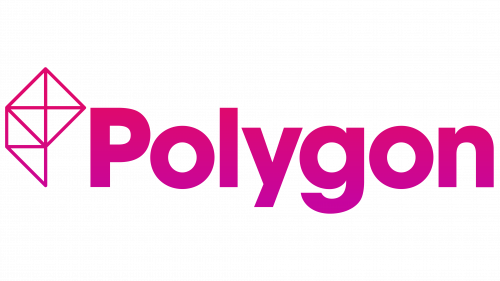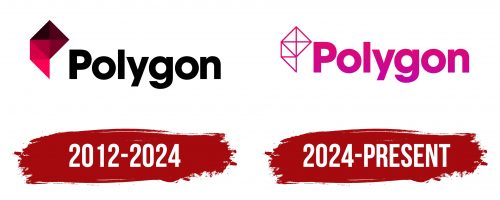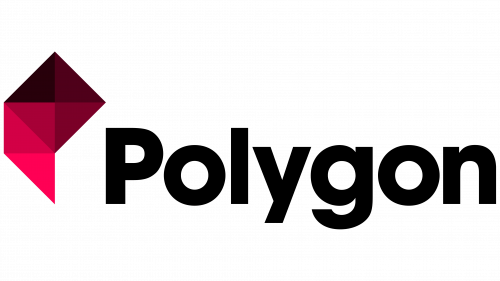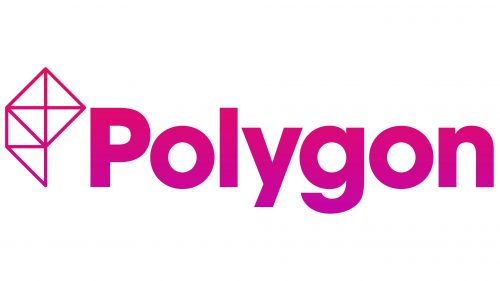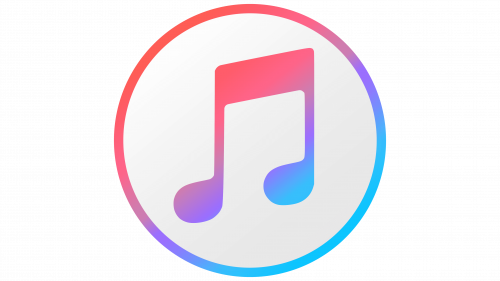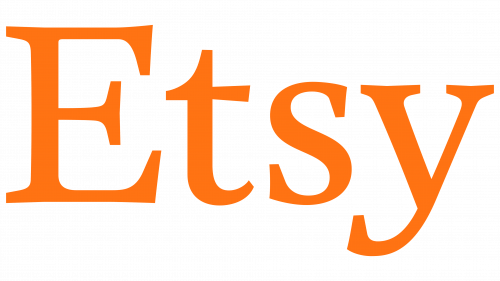The Polygon logo captures attention with its expressive geometry. The central element is an original shape of similar and distinct triangles. This geometric structure is inherited from the early versions of the identity introduced with the launch of the Polygon website. However, the modern version of the emblem has undergone significant changes: it has become more streamlined, and the color palette has been simplified. Users of the platform, which offers a variety of content related to video games, note that the new logo is easy to remember and stands out. And this is a fair observation.
The unique symbol, done in a pink color scheme and placed on a white background, occupies the left side of the logo. To the right, in large letters of the same tone, appears the well-known and popular word “Polygon.” The font is characterized by wide, smooth lines without serifs, creating an impression of confidence and simplicity. The capital “P” slightly touches the two parts of the geometric figure, emphasizing the connection between the text and the symbol, creating a cohesive and complete visual image.
Polygon: Brand overview
Polygon was founded in 2012 as part of the Vox Media network’s expansion. Led by co-founders Christopher Grant, Justin McElroy, and Russ Pitts, the site officially launched on October 24, 2012. The platform aimed to create a journalism-focused gaming news outlet emphasizing in-depth coverage.
The project grew out of “The Verge Gaming,” a gaming blog part of Vox Media’s tech site, The Verge. Vox Media executives saw an opportunity to develop a standalone site dedicated to the gaming industry.
From its launch, the platform set out to provide thorough coverage of the gaming industry, offering not only news but also detailed analysis, developer interviews, game reviews, and explorations of gaming culture.
From the start, one of the site’s defining features was its focus on multimedia content. The site used interactive features, infographics, and videos to create a more immersive experience for its readers, helping set it apart from many other gaming websites at the time.
Early on, the site became known for its high-quality gaming journalism. It attracted several prominent gaming journalists and critics, bolstering its industry reputation.
2013, the platform expanded significantly, increasing its coverage of major gaming events such as Gamescom, E3, and the Tokyo Game Show. The site also began paying more attention to independent games and developers, reflecting the growing importance of the indie scene in gaming.
In 2014, it launched its YouTube channel, significantly increasing its video output. This helped grow the audience and allowed the site to experiment with new content formats, including comedy shows, game development documentaries, and video reviews.
By 2015, the site had broadened its focus, covering topics at the intersection of gaming and culture, such as representation in games, the social impact of gaming, and related issues. This shift reflected the evolving nature of the gaming industry and its audience.
In 2016, the platform introduced podcasts and regular Twitch streams, further expanding its reach and engaging with its audience on new platforms.
In 2017, the platform emphasized the technological side of gaming, increasing its coverage of virtual and augmented reality and delving into the technical aspects of gaming consoles and PCs.
The platform continued to expand its online presence in 2018, producing more content for social media and streaming services. It also began experimenting with new content formats, including long reads and interactive pieces.
In 2019, it shifted some of its focus to esports and streaming culture, actively covering major events and examining how streaming influenced the video game industry.
In 2020 and 2021, the platform adapted to changes in the gaming industry caused by global events. Traditional gaming expos and conferences were replaced by virtual showcases and online events, which it expanded its coverage to include.
In 2022, the platform continued to grow its video content, launching new video series, including documentaries on the history of video games and analyses of game design.
By 2023, the platform had established itself as one of the leading sources of gaming news and commentary worldwide. It continues to evolve alongside the trends in media and the gaming industry.
Over the years, the site has grown from a fledgling gaming news platform into a trusted source for news and analysis of the gaming world. It has successfully adapted to new content formats and distribution channels while staying committed to high-quality journalism and in-depth analysis.
Meaning and History
What is Polygon?
This online resource dedicated to games and entertainment has become a key source for news, reviews, and analysis related to video games. It stands out among competitors due to its in-depth reporting approach and unique editorial style, combining professional journalism with a passion for gaming. The platform offers a wide range of content, from news summaries and game reviews to long-form articles and video series, catering to casual gamers and dedicated enthusiasts. The authors often address broader cultural and social aspects, highlighting how video games influence modern society and interact with other forms of art and media.
2012 – 2024
2012, the Polygon website launched, initially positioning itself as a gaming blog. However, within a short period, the portal significantly expanded its scope and transformed into a multi-topic resource offering diverse materials on video games and related culture. This gaming portal is closely tied to and owned by Vox Media.
Simultaneously with the website launch, the first Polygon logo was introduced, which is important in strengthening brand recognition. The logo was minimalistic but impressively beautiful and stylish. It featured a single symbol and one word, which looked concise yet elegant. The geometric figure on the logo was drawn using a carefully selected color palette, creating a sense of depth through shading and highlights on the lines. This 3D effect added dynamism to the logo, which was particularly important for a gaming website where speed and motion play a key role.
The logo’s text element was rendered in black, using a bold font. The first letter, “P,” was capitalized and stood out due to its large size, while the remaining letters were elegant and noticeable but less emphasized. The emblem lasted about 12 years until a rebranding brought an updated version of the identity.
2024 – today
The updated logo retained many features of its original prototype but reflected the changes with the website as the platform became a hub for various information about video games; the logo needed to reflect that shift. The figure, which once played a central role, was moved to the background, giving prominence to the resource’s name.
The new logo’s font and color palette draw particular attention. The letters became more refined and precise, while the color gradient—from soft pink to deep purple—added dynamism and depth. This transition creates a smooth effect, resembling a waterfall, symbolizing continuous motion, perfectly aligning with the gaming industry. Additionally, the shine and glow of the letters resonate with the video game theme, adding a touch of visual charm.
The modern identity seamlessly combines respect for traditions with contemporary graphic solutions. The figure that forms the core of the logo retains its precision, and the transparency of the central elements of the triangles creates the same sense of depth that makes the logo so recognizable and visually appealing.
